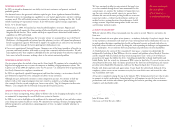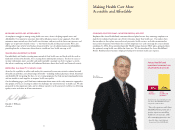Aetna 2004 Annual Report Download - page 13
Download and view the complete annual report
Please find page 13 of the 2004 Aetna annual report below. You can navigate through the pages in the report by either clicking on the pages listed below, or by using the keyword search tool below to find specific information within the annual report.
23
New Financing Tools Give
Consumers More Power and Control
over Health Care Decisions
GRACE-MARIE TURNER
Founder, President and Trustee
Galen Institute, Inc.
After years of rising health costs, the health care marketplace
clearly is ready for a fresh idea. That idea has come in the form
of new incentive programs and products that engage consumers
as partners in managing health costs.
Health Savings Accounts are a bright new star in the field of
consumer-directed health care. HSAs were created as part of the
Medicare Modernization Act and became available January 1,
2004. They allow individuals, employers or employees to invest
tax-free dollars in health accounts to pay for routine health care.
The accounts are accompanied by insurance policies to cover
larger medical bills.
America’s Health Insurance Plans surveyed its members and found
that 438,000 people had purchased HSAs in the first nine months
of last year. The study also found that 30 percent of them were previously uninsured. Other studies
have shown that 40 percent of HSA purchasers earn less than $50,000 a year, about one-third of
purchasers are families with children and half are over age 40, showing they have broad appeal.
But HSAs are just one example of a constellation of offerings that give consumers more power and
control over health care decisions. Other consumer-directed products such as Health Reimbursement
Arrangements are helping companies to lower their health costs while providing incentives for
employees to be more engaged in managing costs and care. Employers and health plans are smoothing
the way by providing access to existing networks and online information tools. They also are
instituting new programs to provide better coordinated care for those with chronic conditions such
as diabetes, heart disease and asthma.
Some companies that have replaced their traditional health insurance with consumer-directed plans
have seen their health costs fall by more than 10 percent, even as the use of preventive services by
workers increased by as much as 23 percent.
Consumers are taking steps into this new world, but many changes still are needed for larger uptake
in the marketplace. The Internet allows consumers easy access to a wealth of medical information
that was available only to professionals as recently as a few years ago. But they still need more –
and more easily accessible – information about prices, quality and outcomes to help make them
smarter consumers.
Some say that consumer-directed health care means shifting more of the cost burden onto consumers.
However, it really is a way of making the costs that consumers already are paying more visible so
that they can be involved in decisions about how they want to allocate their health care dollars.
Consumer-directed health care means many things to many people. But its genius is in putting the
American consumer to work to reshape the health care marketplace to provide more affordable
health insurance, better and more affordable health care and new incentives for people to take
responsibility not only for their health care spending but also for their health.
HSAs allow
individuals, employers
or employees to invest
tax-free dollars in
health accounts to pay
for routine health care.
























